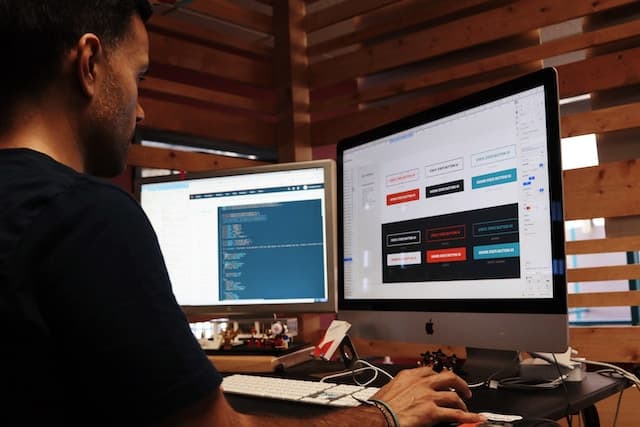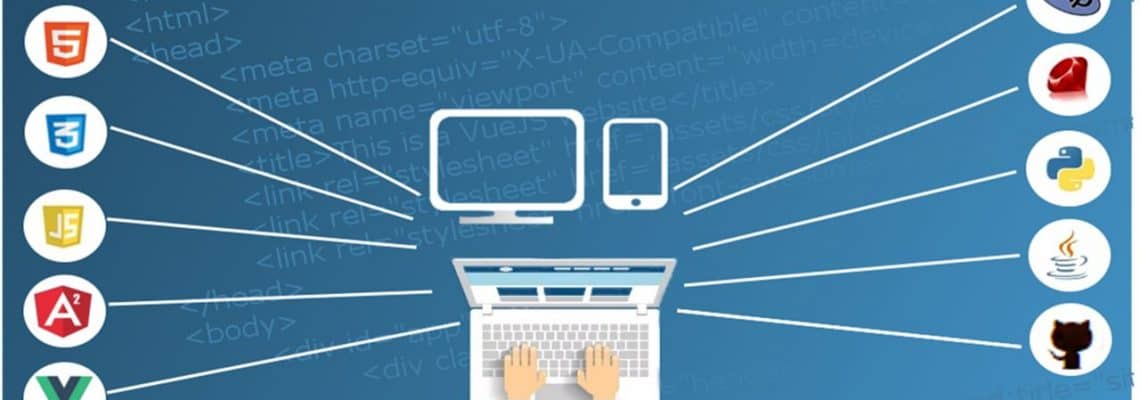The words “web designer” and “web developer” are sometimes used synonymously in web development. That might be perplexing to outsiders who aren’t familiar with the business world. However, the functions of these two careers are different. When it comes down to it, a web designer is the one who decides how a site looks and how its users interact with it. A web developer works on a website’s backend, code, and function. Get the detailed comparison on web designer vs web developer.
We’ll dissect the distinctions between web designers and web developers. That entails not just the individual talents of each member, but also their collaborative approach throughout website creation. Businesses and individuals may save time and money in the website development process by learning the difference between the responsibilities of web designers and those of web coders.
What is a Web Designer?
A web designer is a person who works with the interface of a website. He is responsible for the visual design and user experience of a website. Web designers focus on determining the layout, color scheme, typography, and overall look of the website. Web designers create a website that is aesthetically pleasing and easy for visitors.
Role and responsibilities of a web designer

Web designer design the website’s layout.
Web designers play a crucial part in making websites available, usable, and aesthetically pleasing. Building a website is the main job of a web designer. That needs to fit in with what the customer wants and needs. They should also keep the site’s visitors in mind.
Visual designers are of special concern to visual artists. Color theory, typeface, and other aspects of graphic design are put to use by these pros. It’s crucial to ensure the website’s aesthetic style conveys the intended message. Website usability is another major focus for a visual designer. The visible order must be clearly established. Users can swiftly access the information they require.
Developing wireframes and mockups is another crucial part of a web designer’s job. The first step is to plan the site’s structure on paper. The positioning of different aesthetic components is also dependent on this. The finished product is based on the work done in creating the wireframes and mockups. Before a website is created, the creator can make any necessary modifications.
Skills required to be a web designer
There are several must have abilities for any aspiring web designer. The majority of online designers also have extensive experience in graphic design. This calls for expertise in color theory, font, and page arrangement. Also, they have experience with various modeling programs. Photoshop, Sketch, and Figma are just a few examples. Wireframing and prototyping are familiar territories for them.
Most web designers know HTML and CSS and have an eye for aesthetics. These elements form the basis of any good website. They are also well versed in flexible layouts. Making a website responsive means working on a wide range of platforms.
Knowledge of programming languages like JavaScript and jQuery is helpful, but not required, for most site designers. As a result, designers can incorporate more moving parts and user interaction into their websites. For example, slides and moving images.
Web designers also need to be great communicators. They frequently interact with customers and team members. One of the most important skills a web designer can have is the flexibility to implement suggestions for improvement.
Examples of tools used by web designers
Designers of user friendly and aesthetically pleasing web pages use many resources. Adobe Photoshop, Sketch, and Figma are widely used as design tools. It facilitates the production of mockups, wireframes, and final products. The tools here let artists try various color palettes, typefaces, and layouts before committing to one.
User interface designers use the same software to create websites. Tools like Axure and InVision can be used to prototype and refine user interfaces. They might use code editors as well. HTML, Cascading Style Sheets (CSS), and Java Script are all examples of programming languages. They use these to implement visual elements and visual aspects into the website. They use some other tools like content management systems, responsive design frameworks, etc.
Types of web designers

A initial skech is making by a web designer.
Different kinds of site designers exist. One type is a freelance web designer. They work for themselves, their own companies, or design firms. Web designers who take clients on a freelance basis do so freely. They typically have short term, project based contracts. They must handle customer acquisition and scheduling on their own.
A successful web designer excels at his craft and has a solid graphic design background. They are also very good at talking to people and fixing problems. They can make web pages that do what the customer wants them to do. Web designers also make for a pleasant experience for the consumer. (UX).
There is a subset of computer designers known as UI designers (User Interface). Their main concern is making software and internet layouts simple and straightforward to use. They constitute the actual interaction with the consumer.
Average Salary of a Web Designer
The salary of a web designer varies depending on factors. For example, their level of experience, location, and industry. According to the US Bureau of Labor Statistics, the average web designer gets around $75,200 annually. If you are an expert, you can expect $80000-$142000.
What is a Web Developer?

Web development is the next step of web design.
A web developer works exclusively with the coding and infrastructure of web pages. Web developers play a vital role in developing websites. Web engineers are indispensable to any successful project involving a website. To put the visual ideas of web artists to life, he works closely with them.
Role and responsibilities of a web developer
A web developer’s main role is in creating the website’s underlying code and software. To do this, you’ll need to learn coding and programming languages like HTML, CSS, and JavaScript. It’s a big assist when designing the site’s framework, visuals, and features.
Server side coding languages and databases are also common tools for web writers. Websites can be made live and engaging with the help of languages like PHP and Python. Their job is to keep the facility running smoothly and safely.
Web engineers need to be adept at both coding and issue solutions. They must also be capable of critical thought. They can use it to spot and fix technological problems faster. Also, in order to maintain a competitive edge, they need to learn about and adopt new technologies and business trends as they emerge.
Skills required to be a web developer
To be a successful web developer requires several soft and technical skills. A strong foundation in coding languages such as HTML, CSS, and JavaScript is essential. Additionally, a web developer must have experience with server side scripting languages. PHP, Python, and Ruby are examples. They should also know databases and content management systems.
Web developers must also have strong problem solving and analytical skills. It helps them to identify and troubleshoot technical issues. Attention to detail and the ability to work well under pressure are also essential skills for a web developer. They often need to work on tight deadlines. They must ensure that their work is accurate and error free.
Effective communication skills are also important for web developers. They often have to work closely with clients, project managers, and other web development team members.
Examples of tools used by web developers
A web developer relies on various software to build and manage web pages. Tools like integrated programming platforms are frequently used. (IDEs). The IDEs Visual Studio Code and Sublime Text are two such examples. As such, you have access to a full set of resources for developing and fixing your website.
Web developers who work on the web also use version control. Tools like Gulp and Grunt, known as “task runners,” are used to handle routine coding chores and control modifications to the codebase. Tools like site analytics apps are also widely used. Google Analytics is one such case. In this way, producers can monitor how their sites are used.
Types of web developers
As with any industry, web development has its specialties. Their expertise lies in various facets of the design and web development industries. A front end developer of a website prioritizes the user experience. Languages like HTML, CSS, and JavaScript are examples. They are in charge of designing the customer experience for the website. They guarantee a problem free interface as well.
Meanwhile, back end coders are concerned with things like server side coding and data administration. They also pay attention to the more unseen parts of creating a website. They are in charge of developing and managing the website’s underlying framework. Full stack developers guarantee its safety and functionality.
Full stack web developers are well versed in both the front end and the back end. As far as site creation goes, they can do it all. A web coder comes in a wide variety, with mobile app writers being one subset. They are experts in the development of apps for mobile devices. The goal of a good user interface and user experience creator is to make the customer’s life easier.
Differences Between Web Designers and Web Developers

Differences Between Web Designers and Web Developers Comparison
There are two main types of professionals in the web development industry: web designers and web developers. Each person brings a special collection of abilities and duties to the table. While they do share some similarities, there are also important distinctions that put them apart.
The aesthetic elements of a website are the primary focus of a web designer’s work. The structure, color palette, and typeface are all part of the design. Many different kinds of modeling applications and hardware are employed. It’s useful for giving a website its definitive aesthetic tone. They put a premium on providing a fun and easy interface for users. A web designer typically comes from a visual arts background. Adobe Photoshop, Illustrator, and Sketch are all familiar tools for them. Know the differences of web designer vs front end developer in depth.
However, web engineers are in charge of all the behind the scenes coding that goes into making a website work. That involves things like writing code and running scripts on a computer. They employ many different languages for coding. For instance, a website’s features can be built using markup languages like HTML, CSS, and JavaScript. The development instruments at their disposal are in skilled hands. Tools like revision control and integrated development environments (IDEs) fall under this category.
Portfolio of a Web Designer vs a Web Developer?
There can be a big difference between a web designer’s and a web developer’s resume. This entails the various types of expertise needed by various occupations. In most instances, a web designer’s resume will feature examples of their work created with various design programs. It’s evidence that they can design websites that are both beautiful and easy to navigate.
On the other hand, the resume of a web coder could feature examples of their code. This demonstrates their proficiency with programming tools and their ability to create sophisticated websites and apps. The individual’s skills and areas of knowledge should be highlighted in both portfolios. The professional’s position will determine the primary concerns and topics covered. The main difference between a web developer and a web programmer is one make web pages and other one manage the back end of web pages.
Career Opportunities: Web Designer vs Web Developer
Both web designers and web developers have a range of career opportunities available. Web designers can pursue careers in graphic design, UX design, or UI design. They may work in house for a company or organization, or as freelancers or consultants. Web designers may also specialize in a specific industry. For example, e commerce or healthcare.
A web developer, on the other hand, has a wider range of career paths available to them. Their skills are highly in demand across a variety of industries. They may pursue careers as front end developers, back end developers, and full stack developers. A web developer may work for large tech companies or startups. He/she can be a freelancer or consultant. They may also specialize in specific coding languages or frameworks. For example, React, Angular, or Node.js.
Which is the Best Career for You?

Deciding between a career as a web designer vs a web developer depends on several factors. That includes individual interests, skills, and career goals. If you have a passion for design, a keen eye for aesthetics, and enjoy creating visually appealing websites, then web design may be the best fit for you. However, if you have a strong interest in coding, then web development may be the better choice. It’s important to do research. explore different career paths, and gain experience in both fields. It will help you to determine which one aligns best with your skills and interests. Ultimately, the best career choice allows you to thrive and enjoy your work.
Conclusion
The debate of Web Designer vs Web Developer is an ongoing one. Both professions play an important role in website creation and development. Web designers focus on the visual aspects and user experience of a website. In contrast, web developers focus on the technical and functional aspects of the site. Both professions need a different set of skills, tools, and knowledge. They can complement each other to create a cohesive and effective website.
It’s essential to clearly understand your strengths, interests, and career goals. Both professions offer a range of career opportunities. Each has its unique set of challenges and rewards. Ultimately, the best career choice for you will depend on several factors. It includes individual preferences, skills, and interests. So, whether you’re a Web Designer or Web Developer, the future looks bright for both professions.
